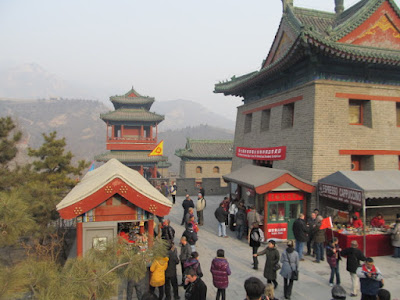(This is a guest post from the husband of the blogger.)
Last week I attended the 7th International Strawberry Symposium, held in Beijing. Of the seven, I have only missed one. This one was the largest (~1000 delegates) and probably the most interesting from a scientific as well as cultural standpoint.

The site of the conference was building #16 of a resort complex. It had over 1000 rooms and three very large halls. There were lots of security people (Beijing Police, military, etc.) around to keep us in line and to prevent us from photographing the hotel. This image was from the bus as we were leaving.
The hotel lobby from the third floor.
These gals escorted dignitaries and posed for ordinary folks just wanting pictures.
In advance of the conference, a strawberry-themed exhibition centre and "theme park" were constructed. Money seems to be no obstacle to showing who is #1 in world strawberry production.
Our tour guides awaiting us.
Production is mostly in these (passive) solar houses. There are thousands of them north of Beijing.
The north brick wall is about 70 cm thick. It absorbs heat during the day and releases it at night. Even though the outside temperature may be -10 C, the inside temperature doesn't drop below about +8 C. Would this work in Nova Scotia tucked into the North mountain?
This experimental vertical system would go well in my kitchen.
A street scape viewed on our trip to the Juyongguan pass of the great wall.
Sixteen tour buses parked behind this arch.
The wall at this pass was designed to keep out invaders from the north.
It was a smoggy, hazy day (very common in the vicinity of Beijing). The wall climbs the mountain with watch towers at the peaks.
I walked up to the first tower. The stairs were uneven in height and very steep. A good cardio workout!
Proof that I am not making it all up.
Very steep!
Normally, the wall wouldn't have this many people on it.
Detail on the eves of the Cloud Terrace.
The wall climbs the mountain on the opposite side of pass as well. The great wall is a sort of pilgrimage site for the Chinese. From rural villages around the country, people desire to visit the great wall once in their lifetime.
Some old-school weapons.
Looking from the wall into a village.
Ditto.
Tourist shops. Note the red banner which welcomes the Strawberry Symposium delegates.
Very ornate!
You have heard of a wall-flower, how about a wall-cat.
After leaving Juyongguan pass, we headed for the Ming tombs. Ming Dynasty emperors starting about 600 years ago built some fancy burial places for themselves and their favourite gals (who were interred at the same time as the emperor) along with some other possessions. There were 13 Ming tombs. We visited the Dingling tomb which has been excavated and restored. All of the tombs were located in an area chosen for its favourable feng shui.
Approaching the Dingling tomb, you can just see the soul tower which is just before it.
The tree of choice is the Imperial Cypress. A closer look at the leaning ones in the distance show...
... that the leaners are actually made of concrete. Many of these cypresses are well over 200 years old, ...
... and they even grow out of the walls.
The soul tower, contains a sculpted obelisk...
...which has a series of...
... dragons encircling it.
Descending 75 metres into the tomb...
... you pass through several arches which have doors of copper...
... then jade, each with 9 x 9 knobs which likely have some religious significance.
There were thrones, just in case his spirit needed a place to sit.
And finally, the final resting place. The emperor would be in the biggest one. Apparently the builders of this tomb would have been executed so they wouldn't tell others where it was located.
On a lighter note, a couple of humorous signs.
This was just below the shower head in my hotel room's bathroom.
Self explanatory in any language.
Thanks for sticking to the end. It translates "I Love Beijing".









































Hey Mom and Dad!
ReplyDeleteThanks for posting these photos, it looks like you had an incredible trip. I can't wait to hear more about it in person/see more photos. I love the ones of the trees growing out of the walls and the gorgeous one with some of the details of Cloud terrace with the wall in the background! Lots of love.
Heather